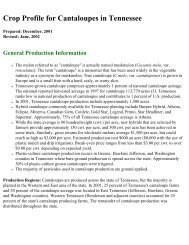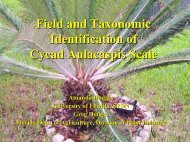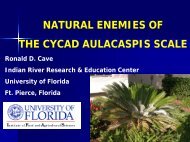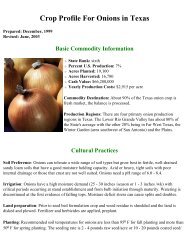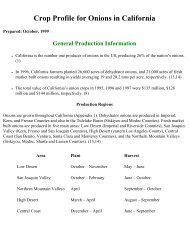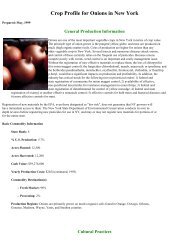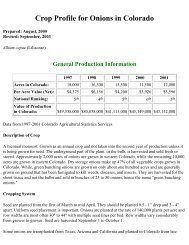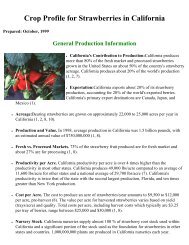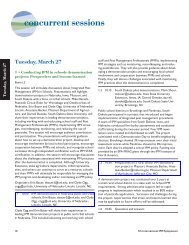Crop Profile for Cherries (Sweet) - Regional IPM Centers
Crop Profile for Cherries (Sweet) - Regional IPM Centers
Crop Profile for Cherries (Sweet) - Regional IPM Centers
You also want an ePaper? Increase the reach of your titles
YUMPU automatically turns print PDFs into web optimized ePapers that Google loves.
Bacterial Canker<br />
Pseudomonas syringae pv. syringae<br />
Pseudomonas syringae pv. morsprunorum<br />
Bacterial canker is a significant disease affecting stone fruits in all world production areas. The same<br />
pathogen also may attack apples and pears and a wide range of hosts other than tree fruits. The disease is<br />
also called bacterial gummosis, Pseudomonas canker, and Pseudomonas blight. The pathogen may<br />
attack various parts of the tree, where it may be called blossom blast, twig blight, shoot dieback, or<br />
bacterial shothole. This disease has been difficult to study and control, as the pathogen is very<br />
widespread, lives as an epiphyte on the host and weeds, invades host tissues without inducing<br />
symptoms, and causes disease that has symptoms similar to those caused by other pathogens. Cherry<br />
trees are commonly hosts of the causal organism, but disease does not occur unless the climate is<br />
conducive and the host predisposed. Young cherry trees are the most seriously affected, as trunks are<br />
often girdled or severely damaged. Trees affected during the first three seasons after planting are often<br />
killed outright or grow so poorly that they must be removed.<br />
There are two variants (pathovars) of the causal bacteria: Pseudomonas syringae pv. syringae attacks a<br />
wide range of commercial stone fruit cultivars and Pseudomonas syringae pv. morsprunorum attacks<br />
mostly cherry (sweet and sour) and plum. P. syringae pv. syringae is the more common pathovar in<br />
Washington.<br />
The bacteria overwinter inside of host plants, usually along the edge of cankers that grew the previous<br />
season, or in infected but symptomless buds or other host tissue. Bacteria spread from overwintering<br />
sites to grow epiphytically on tree, leaf, flower and weed leaf surfaces. Moist, cool weather favors the<br />
spread and growth of bacterial colonies. Rain and wind serve as the primary means of local dispersal.<br />
Temperatures above the low 80s° F, dry weather, and low relative humidity cause a rapid decline in<br />
epiphytic populations of the bacteria, which survive the summer inside of host tissues. Temperatures<br />
over 95° F may greatly reduce the numbers of bacteria surviving inside of plant tissues.<br />
Winter cold or spring frost injury may weaken plant parts and give systemic, symptomless bacterial<br />
colonies the conditions conducive to rapid growth, leading to disease symptoms. Frost, especially when<br />
closely followed by rain or heavy dew, leads to bacterial blast of blossoms. Winter injury, pruning<br />
during or within a few days prior to wet weather, or wounds may provide bacteria access to the<br />
cambium, where infections may lead to canker development. In areas of the world that have cool, wet<br />
winters, infection of pruning wounds during the fall or winter is common. Washington winters are cold,<br />
with precipitation falling mostly as snow. Infection is unlikely during below-freezing temperatures.<br />
Wounds are more likely to be infected in late winter through spring when temperatures are mild and<br />
trees may be wetted <strong>for</strong> several hours. Serious infections have occurred on young trees that were wetted<br />
by rain or irrigation within a few days of planting or after suckers were removed from trunks.



